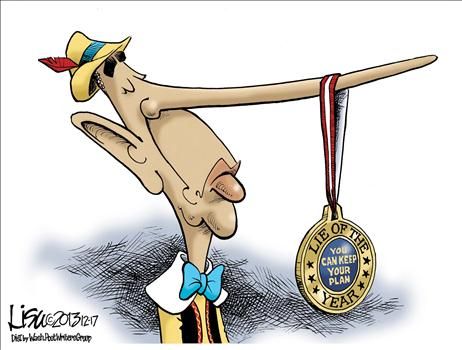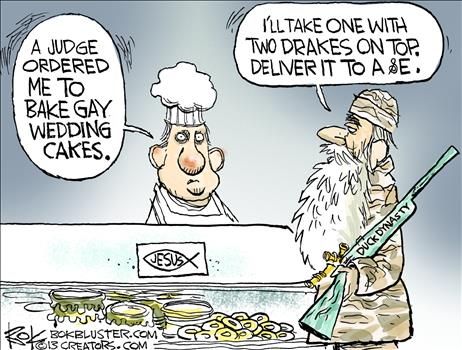
The lie of the year, according to Politifact, is “If you like your health care plan, you can keep it.” But the story of the year is a nation waking up to just how radical Obamacare is — which is why it required such outright deception to get it passed in the first place.
Obamacare was sold as simply a refinement of the current system, retaining competition among independent insurers but making things more efficient, fair and generous. Free contraceptives for Sandra Fluke. Free mammograms and checkups for you and me. Free (or subsidized) insurance for some 30 million uninsured. And, mirabile dictu, not costing the government a dime.
In fact, Obamacare is a full-scale federal takeover. The keep-your-plan-if-you-like-your-plan ruse was a way of saying to the millions of Americans who had insurance and liked what they had: Don’t worry. You’ll be left unmolested. For you, everything goes on as before.
That was a fraud from the very beginning. The law was designed to throw people off their private plans and into government-run exchanges where they would be made to overpay — forced to purchase government-mandated services they don’t need — as a way to subsidize others. (That’s how you get to the ostensible free lunch.)
It wasn’t until the first cancellation notices went out in late 2013 that the deception began to be understood. And felt. Six million Americans with private insurance have just lost it. And that’s just the beginning. By the Department of Health and Human Services’ own estimates, about 75 million Americans would have plans that their employers would have the right to cancel. And millions of middle-class workers who will migrate to the exchanges and don’t qualify for government subsidies will see their premiums, deductibles and co-pays go up.
It gets worse. The dislocation extends to losing one’s doctor and drug coverage, as insurance companies narrow availability to compensate for the huge costs imposed on them by the extended coverage and “free” services the new law mandates.
But it’s not just individuals seeing their medical care turned upside down. The insurance providers, the backbone of the system, are being utterly transformed. They are rapidly becoming mere extensions of the federal government.
Look what happened just last week. Health and Human Services unilaterally and without warning changed coverage deadlines and guidelines. It asked insurers to start covering people on Jan. 1 even if they signed up as late as the day before and even if they hadn’t paid their premiums. And is “strongly encouraging” them to pay during the transition for doctor visits and medicines not covered in their current plans (if covered in the patient’s previous — canceled — plan).
On what authority does a Cabinet secretary tell private companies to pay for services not in their plans and cover people not on their rolls? Where in Obamacare’s 2,500 pages are such high-handed dictates authorized? Does anyone even ask? The bill itself is simply taken as a kind of blanket warrant for HHS to run, regulate and control the whole insurance system.
Remember the uproar over forcing religious institutions to provide contraception coverage? The president’s “fix” was a new regulation ordering insurers to provide these services for free. Apart from the fact that this transparent ruse does nothing to resolve the underlying issue of conscience — God sees — by what right does the government order private companies to provide free services for anyone?
Three years ago I predicted that Obamacare would turn insurers into the lapdog equivalent of utility companies. I undershot. They are being treated as wholly owned subsidiaries. Take the phrase “strongly encouraging.” Sweet persuasion? In reality, these are offers insurers can’t refuse. Disappoint your federal master and he has the power to kick you off the federal exchanges, where the health insurance business of the future is supposed to be conducted.
Moreover, if adverse selection drives insurers into a financial death spiral — too few healthy young people to offset more costly, sicker, older folks — their only recourse will be a government bailout. Do they really want to get on the wrong side of the White House, their only lifeline when facing insolvency?
I don’t care a whit for the insurance companies. They deserve what they get. They collaborated with the White House in concocting this scheme and are now being swallowed by it. But I do care about the citizenry and its access to a functioning, flourishing, choice-driven medical system.
Obamacare posed as a free-market alternative to a British-style single-payer system. Then, during congressional debate, the White House ostentatiously rejected the so-called “public option.” But that’s irrelevant. The whole damn thing is the public option. The federal government now runs the insurance market, dictating deadlines, procedures, rates, risk assessments and coverage requirements. It’s gotten so cocky it’s now telling insurers to cover the claims that, by law, they are not required to.
Welcome 2014, our first taste of nationalized health care.
Read more from Charles Krauthammer’s archive, follow him on Twitter or subscribe to his updates on Facebook.





